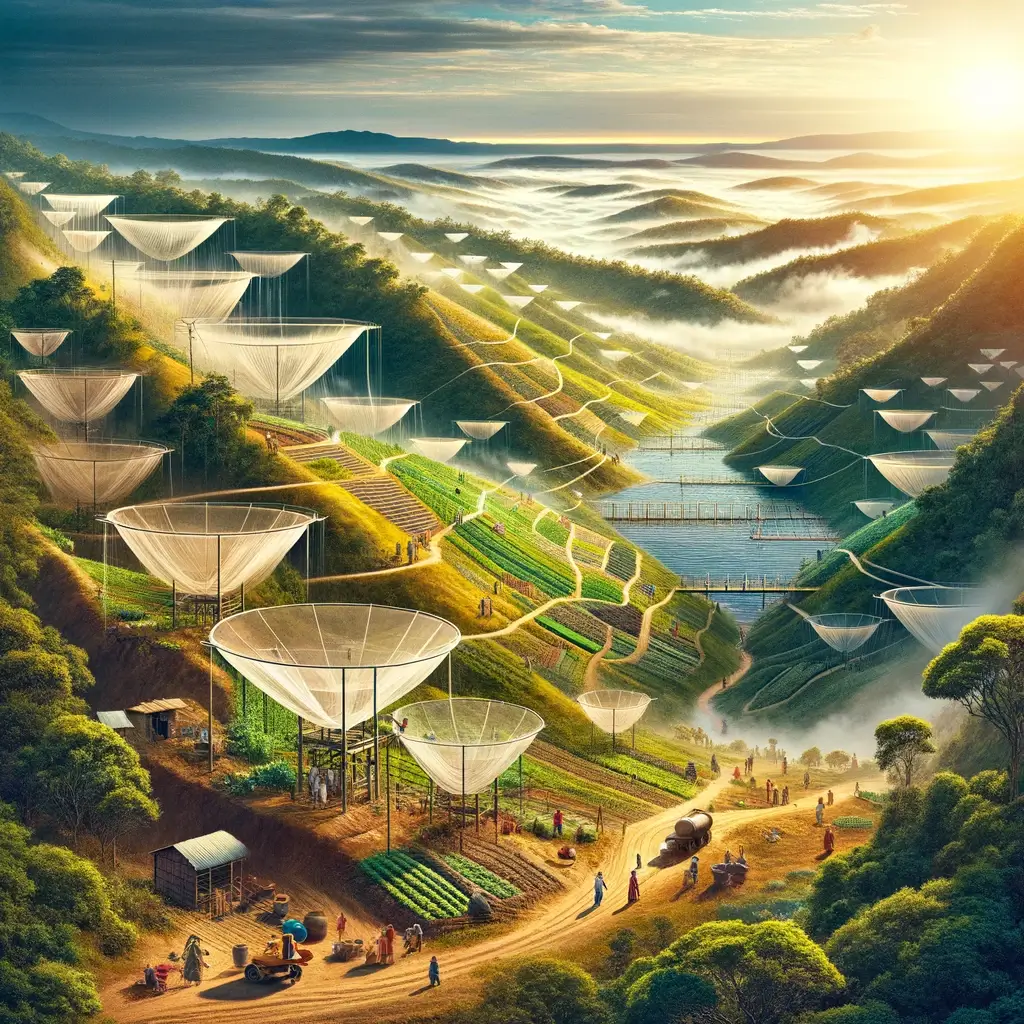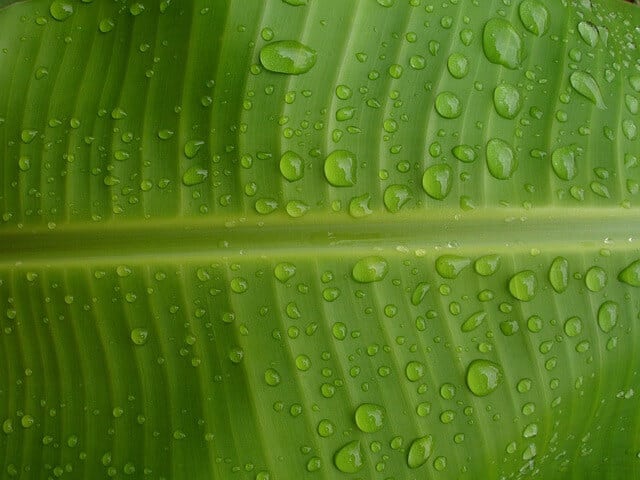
Abel Cruz was only a child when he first realized that he could use banana leaves to save him an entire hour of work every day.
Cruz grew up in Peru, an area known for its lack of water. The residents pray every winter for rain, and are often disappointed far too often. Cruz, like many women and children in Peru, had to spend an hour of his time each day walking to the well, pumping water and carrying it back to the village in heavy buckets. And if the well has become contaminated or dried up? Then the whole village was in danger.
Luckily for Cruise, he was lazy. And perhaps it is more correct to say: effective. He was looking for a way to work less hard - and still bring water to the village. The banana fell into his mind as a ripe fruit. He noticed drops of water that had pooled and accumulated on the large banana leaves, and together with his father he built canals paved with banana leaves to collect the water. When the banana leaves dried after several weeks, the father and his son built new canals from halves of thick bamboo stalks. These have already survived - and continued to provide water - over time.
Cruise was not the first person to realize that water could be collected from the air. The earliest evidence of this technique comes from 16th century engravings from the island of El Hierro in the Canary Islands, near Morocco. The island often suffered from a lack of water, and the inhabitants had to drink the drops directly from the bushes. The more advanced placed containers under the trees to collect the liquid precious. This is an accepted technique in any region of the world that enjoys high humidity and suffers from a lack of rainwater.

Water on a banana leaf. source: Pixabay
But Cruise decided he could make her even better.
In the years that have passed from his childhood until today, Cruz managed to establish an organization called the "Peruvian Movement Without Water". The organization helps provide water to communities throughout South America, through large networks stretching across the hills. The nets capture the tiny water droplets floating in the thick Peruvian mists. The drops accumulate, coalesce, become heavier and finally drip down pipes that concentrate the water in large tanks. Thanks to Peru's unique climate, each network can yield between two hundred for four hundred liters of drinking water per day. More than two thousand such networks have been installed in eight local communities in Peru, Bolivia, Colombia and Mexico. The result? Abundance in water.
"In places where there used to be lots of trees, there is agriculture today." Cruz said In an interview with the BBC In 2020. “In Tana, there is one man raising a thousand chickens with fog-catchers. ... There are families who grow figs, vines and olives, in places where you would never imagine you would see a harvest."

Sound promising? Do you want to place a net on your home balcony? Now comes the bad news. The fog trap technology is inherently limited to areas with high humidity. There is a reason why Cruz's organization focuses on very specific areas in South America. It could not operate at the same level of efficiency elsewhere in the world.
At least not before a new inventor came along and improved it into a more than billion dollar industry that supplies water to more than fifty countries.
water from the sun
Cody Friesen, an inventor and professor of materials science at the University of Arizona, was very familiar with fog nets and their limitations. In 2014, he founded the company known today as "Source Global" and provides one, large and special invention to communities all over the world: hydro-panels. Or in simple Hebrew: panels that produce water - from the air.

The panels contain advanced technology, the kind that was not available to Cruz or the residents of El Hiero, and rely on it to produce water even from air with low humidity percentages. Fans draw the air into the panel, where it encounters a moisture-absorbing material that absorbs… moisture. That is, water molecules. When the temperature rises, the water molecules separate from the material and enrich the air with moisture. Then, finally, that moist air gets trapped and leaks out of the panel in the form of water. With a small addition of minerals, they are too worthy of drinking.
Astute readers have surely already understood that this whole process requires a significant investment of energy. The fans do not work out of their kindness, and in order to make the water separate from the material that adsorbed it, a high temperature is needed on demand. Fortunately for Friesen, he is multidisciplinary: the previous company he founded focused on energy storage in batteries in remote areas. Friesen had the necessary energy experience to figure out how to match the hydro-panel with a solar panel. These two technologies have been combined into one invention that is able to provide water without connecting to electricity. According to Friesen's reports, the hydro-panel is capable of producing water even in humidity conditions of five percent or less.
Friesen obviously has a vested interest in promoting the hydro-panels. It is hard to believe that they are able to reach a high level of performance even in very low humidity conditions. The costs are also not negligible: one panel costs about two thousand dollars, is able to work for 15 years and supplies 4-5 liters per day. That is, enough drinking water for a small family. Despite these limitations, success seems to be evident on the ground: Friesen's company currently operates in more than fifty countries, and has an estimated value of More than a billion dollars.
This is a high valuation, but it may be justified, because if there is one thing that is clear to us - it is that technologies tend to improve and become more efficient over the years. The new technology that Friesen is now starting to incorporate into hydro-panels is artificial intelligence. Through constant monitoring and analysis of weather conditions, humidity, temperature, sunlight and more, each panel can adjust its mode and time of operation to produce more water - with a lower energy investment. The optimistic prediction is that artificial intelligence will be able to double the daily amount of water supplied by each hydro-panel.
And everyone has already noticed.
The race is widening
There is nothing unusual in the evolution of the technologies for producing drinking water from the air. We started with simple manual labor (sucking leaves that had absorbed moisture), progressed to direct utilization of those leaves by paving canals, found ways to replace the leaves with bamboo to improve the process, and then improved it even further with nets. The really great progress, which allowed many to enjoy the water in the air, came from other directions of science and technology: materials engineering that provided the moisture-absorbing material, solar panels for the benefit of energy and soon also artificial intelligence to improve efficiency.
Now, as a natural continuation of this process - which parallels can be seen in every field today - inventors all over the world are taking the same ideas and applying them in a variety of different ways. The BBC recently released an article detailing some of the leading and more interesting companies in the field.
Want a cup of coffee that never ends? At the beginning of 2024, the Kara Water company launched coffee machine which fills itself with water... from the air. Water, as we know, is a key ingredient in coffee, and with the addition of just one capsule, you can cut yourself off from dependence on urban infrastructure. At least one cup a day. You can join the waiting list today to order the machine for only NIS 929, plus shipping.
Do you avoid coffee? There is also a cooler that produces ten liters of water on a day from the air. Do you also want to go on trips? company Atmospark Selling a device the size of a small wheelbarrow, including wheels, which can produce about ten liters of water on an average day in Israel. On days with particularly high humidity, the number can almost double. Watergen The Israelis intend to soon launch a series of devices for vehicles, which will produce water from the air in trains, buses, ships and even private cars. Want a multi-story building? Panther-Imhotep The Austrians offer a device with an output of 10,000 liters per day. For the whole street? Rainmaker can reach 20,000 liters per day. To the whole neighborhood? Just buy a few units.
Does this mean that all the world's water problems have been solved? of course not. This technology still needs to prove itself over time, and it is also worth asking what will be its effect on the climate if such facilities are spread in high numbers and concentrations. But we are in the right direction to deal with the world's water problems, one way or another.
It will be good - if we do good
This article is not really about water. In fact, he is about hope. The human race has always had to deal with limited resources - water, food, light and more. An important part of what characterizes us as humans is that we have developed sophisticated ways to meet these needs. Not always with great success, but little by little we are improving.
The water problem is becoming more serious these days than ever, thanks to the international climate crisis. At the same time, we see human innovation and diligence also working stronger than ever, and bringing about results that were difficult to imagine in the past - such as water that is produced as if out of thin air, when the energy for the process comes solely from the sun. It is clear to us that as we progress over the years, these technologies will only improve. And if not these - then others. And if not in water, then in the production of energy, food, and every other human need.
I'm not saying that all our existential problems will be solved in the next few minutes. they are not. Millions of laboratories all over the world will have to continue to offer possible solutions, each of which will advance us a little further. Thousands of companies will have to come up with innovative ideas, raise millions of dollars and fail big, before the best solutions are identified. But as long as we continue on this path of experimentation, improvement and optimization - we will eventually reach a better world.
for life
More of the topic in Hayadan:
